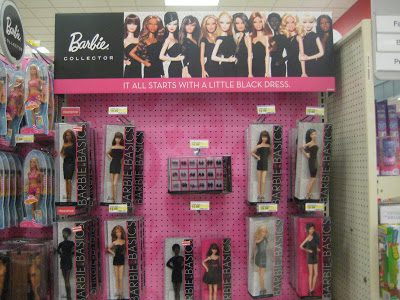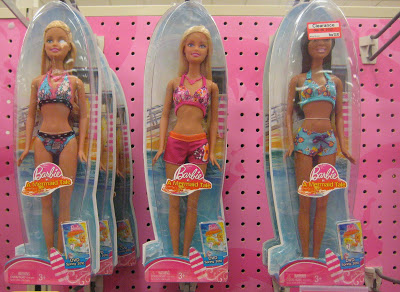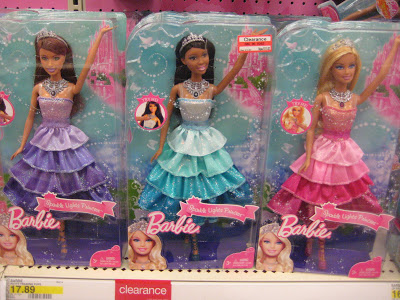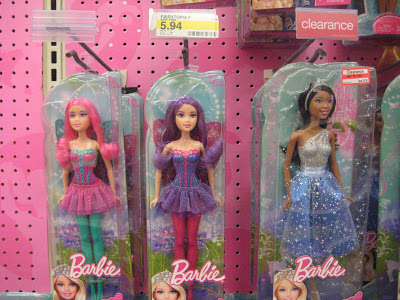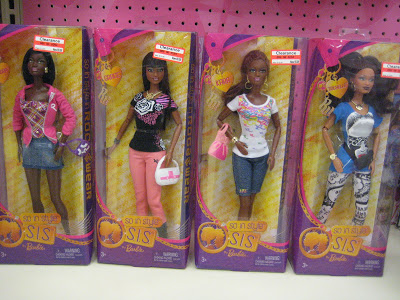Mark and I had a much-anticipated date night tonight, to celebrate our 14th wedding anniversary. We went dinner at our favorite Cuban spot, and then we decided to get crazy and spontaneous, so we went to Target to buy a new rice cooker.
HOT DATE. I know.
We were cutting through the toy aisle on our way to look at the kitchen wares, and noticed a row of multiracial Barbies. Okay, cool. Barbie has got the diversity thing going on. Only, do you notice anything a little off? The red and white clearance sticker on some of the dolls?
We stood there looking at this line of Barbies, and of course I whipped out my camera, because seriously . . . it was just so blatant. The three shades of clearly African American Barbies were on clearance. Every other Barbie was full price.
Then we scanned the rest of the aisle. We found Mermaid Story Barbie. White version, full price. Black version, CLEARANCE.
We found Princess Barbie. White version, full price. Black version, CLEARANCE.
Fairy Barbie. Same story.
The only consistent pricing for the Barbies was the So In Style line. They were all on clearance. I wonder why?
Mark and I stood there processing this, and I vacillated between that nervous laughing you get when you just can’t believe what you are seeing, and that hot, prickly feeling that creeps up the back of your neck went you just want to punch something.
I started formulating a rant – an angry letter I would pen about this situation. But to who? Is Mattel to blame for this? Clearly, they’ve put some effort into making sure that African Americans are represented in the Barbie line.
Should I be mad at Target? Are they at fault when their consumers show racial bias when they buy toys for their children? Obviously, when mothers are faced with a row full of dolls, they are overwhelmingly choosing the white dolls, prompting Target to discount the ones that aren’t selling. (And even with the discount, parents are choosing the white dolls).
And really, the only conclusion I can come to is that WE are to blame. Our society. In particular, the white majority that thinks that we are living in a post-racial society because Obama is president, the white majority that thinks that black people are oversensitive when they complain about racism, and the white majority that doesn’t even see the problem with encouraging your kids to choose dolls that look just like them.
(And if you don’t believe me, have a look at an American Doll catalog – which encourages girls to special order a doll with their exact hair, skin, and eye color, because “everyone wants a friend who looks just like them.” Or check out this podcast from This American Life on how mothers at FAO Schwartz react when the store runs out of white baby dolls in the nursery. Parents are faced with a choice: will they go for an Asian, Latino, or African-American baby instead? What happens is beyond disturbing.)
It is only through the lens of white privilege that we can ignore how this kind of “like me = likeable” subtext shapes the way our children interact with others. It is only in the comfortable seat of denial that we can pretend that this preference for same-race dolls won’t extend into our children’s treatment of minority children that don’t look like them.
And really, buying diverse dolls is just the tip of the iceburg in raising a generation that will bridge the racial gap in our country. There are so many bigger things we should be doing as parents, including making sure our community and the people in our lives and in our homes reflect the diversity that we supposedly value. But the dolls . . . I mean, buying diverse dolls is so easy. It takes so little effort. AND WE AREN’T EVEN GETTING THAT RIGHT.
So, who do I rant to about this? At you. At me. At all of us. Not good enough, people. Not good enough.
Some ideas, from a post I wrote a few years ago, on raising our kids to appreciate diversity:
1. Take an inventory of your home’s diversity. Are your toys sending a subtle message? Make it a point to buy dolls and action figures of every race. Watch how your kids react.
2. Be intentional in showing your children positive examples of other races in the media they watch. Some great examples are Go, Diego, Go!, Little Bill, Ni Hao, Kai-Lan, Dora the Explorer, and Cooking for Kids with Luis.
3. Take inventory of your own racial biases. Be careful with the language you use around your children. Avoid making stereotypical statements or racial jokes in front of your children. (or better yet, don’t do it at all). 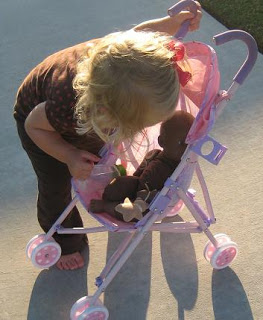
4. Look for opportunities to immerse your family in other cultures. Try to find situations where your family is the minority. This is a great stretching and empathy building opportunity for you and your kids. Try attending a minority church event or a cultural festival. Again, observe your child’s reactions and open a dialogue about how that feels.
5. Read books that depict children from other races and countries. Some of our favorites are We’re Different, We’re the Same, The Colors of Us , and Whoever You Are (Reading Rainbow Book) . For an incredible list of multi-cultural children’s books, check out Shades of Love at Shelfari.com.
6. Just observe. Watch how your children plays with children who are different, whether it be skin color, gender, disability, or physical differences. Talk about it. Let your child know that you are a safe person to process their feelings and reactions with, while at the same time guiding them to accept children with differences.
7. Lead by example. Widen your circle of friends and acquaintances to include people from different backgrounds, cultures and experiences.
*I found out today that I am a finalist for a Blogluxe award (thanks for those who voted for me). I’m in the category for “funniest blog”, which is kind of a lot of pressure. The links went up today, so I know some of you might be visiting for the first time. You know that feeling when someone introduces you with something like, “Hey, this is Kristen, she’s really funny” . . . and then you can think of absolutely nothing funny to say in response? I spend the evening thinking that I need to post something REALLY FUNNY for someone stopping by from the Socialluxe site. And then, well . . . this happened. So, yeah. Sorry? Try me back tomorrow. I might be in a better mood.

